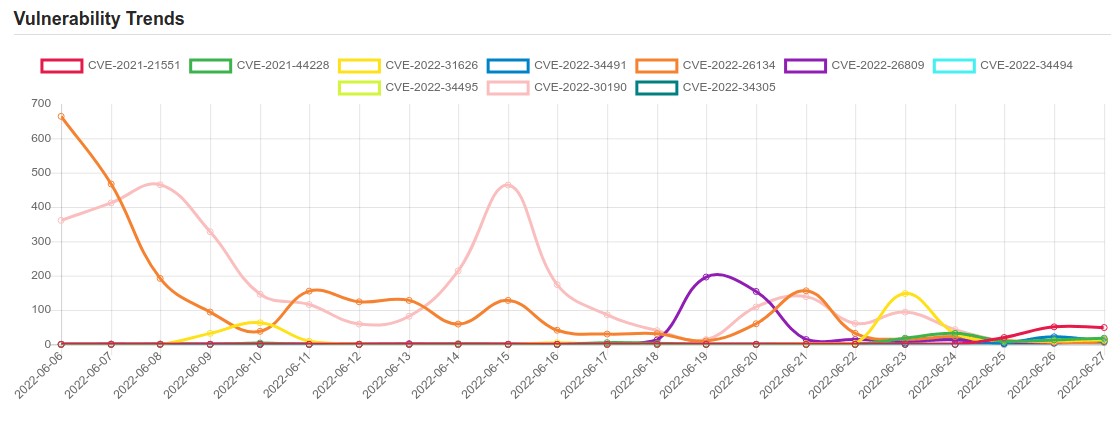Daily Vulnerability Trends: Tue Jun 28 2022

| CVE NAME | CVE Description |
| CVE-2022-30157 | Microsoft SharePoint Server Remote Code Execution Vulnerability. This CVE ID is unique from CVE-2022-30158. |
| CVE-2022-29499 | The Service Appliance component in Mitel MiVoice Connect through 19.2 SP3 allows remote code execution because of incorrect data validation. The Service Appliances are SA 100, SA 400, and Virtual SA. |
| CVE-2021-3560 | It was found that polkit could be tricked into bypassing the credential checks for D-Bus requests, elevating the privileges of the requestor to the root user. This flaw could be used by an unprivileged local attacker to, for example, create a new local administrator. The highest threat from this vulnerability is to data confidentiality and integrity as well as system availability. |
| CVE-2022-31016 | Argo CD is a declarative continuous deployment for Kubernetes. Argo CD versions v0.7.0 and later are vulnerable to an uncontrolled memory consumption bug, allowing an authorized malicious user to crash the repo-server service, resulting in a Denial of Service. The attacker must be an authenticated Argo CD user authorized to deploy Applications from a repository which contains (or can be made to contain) a large file. The fix for this vulnerability is available in versions 2.3.5, 2.2.10, 2.1.16, and later. There are no known workarounds. Users are recommended to upgrade. |
| CVE-2022-33202 | Authentication bypass vulnerability in the setup screen of L2Blocker(on-premise) Ver4.8.5 and earlier and L2Blocker(Cloud) Ver4.8.5 and earlier allows an adjacent attacker to perform an unauthorized login and obtain the stored information or cause a malfunction of the device by using alternative paths or channels for Sensor. |
| CVE-2022-22980 | A Spring Data MongoDB application is vulnerable to SpEL Injection when using @Query or @Aggregation-annotated query methods with SpEL expressions that contain query parameter placeholders for value binding if the input is not sanitized. |
| CVE-2022-33146 | Open redirect vulnerability in web2py versions prior to 2.22.5 allows a remote attacker to redirect a user to an arbitrary web site and conduct a phishing attack by having a user to access a specially crafted URL. |
| CVE-2022-0953 | The Anti-Malware Security and Brute-Force Firewall WordPress plugin before 4.20.96 does not sanitise and escape the QUERY_STRING before outputting it back in an admin page, leading to a Reflected Cross-Site Scripting in browsers which do not encode characters |
| CVE-2021-21551 | Dell dbutil_2_3.sys driver contains an insufficient access control vulnerability which may lead to escalation of privileges, denial of service, or information disclosure. Local authenticated user access is required. |
| CVE-2021-44228 | Apache Log4j2 2.0-beta9 through 2.15.0 (excluding security releases 2.12.2, 2.12.3, and 2.3.1) JNDI features used in configuration, log messages, and parameters do not protect against attacker controlled LDAP and other JNDI related endpoints. An attacker who can control log messages or log message parameters can execute arbitrary code loaded from LDAP servers when message lookup substitution is enabled. From log4j 2.15.0, this behavior has been disabled by default. From version 2.16.0 (along with 2.12.2, 2.12.3, and 2.3.1), this functionality has been completely removed. Note that this vulnerability is specific to log4j-core and does not affect log4net, log4cxx, or other Apache Logging Services projects. |
| CVE-2022-31626 | In PHP versions 7.4.x below 7.4.30, 8.0.x below 8.0.20, and 8.1.x below 8.1.7, when pdo_mysql extension with mysqlnd driver, if the third party is allowed to supply host to connect to and the password for the connection, password of excessive length can trigger a buffer overflow in PHP, which can lead to a remote code execution vulnerability. |
| CVE-2022-34491 | In the RSS extension for MediaWiki through 1.38.1, when the $wgRSSAllowLinkTag config variable was set to true, and a new RSS feed was created with certain XSS payloads within its description tags and added to the $wgRSSUrlWhitelist config variable, stored XSS could occur via MediaWiki’s template system whenever that feed was loaded via the rss document tag. |
| CVE-2022-26134 | In affected versions of Confluence Server and Data Center, an OGNL injection vulnerability exists that would allow an unauthenticated attacker to execute arbitrary code on a Confluence Server or Data Center instance. The affected versions are from 1.3.0 before 7.4.17, from 7.13.0 before 7.13.7, from 7.14.0 before 7.14.3, from 7.15.0 before 7.15.2, from 7.16.0 before 7.16.4, from 7.17.0 before 7.17.4, and from 7.18.0 before 7.18.1. |
| CVE-2022-26809 | Remote Procedure Call Runtime Remote Code Execution Vulnerability. This CVE ID is unique from CVE-2022-24492, CVE-2022-24528. |
| CVE-2022-34494 | rpmsg_virtio_add_ctrl_dev in drivers/rpmsg/virtio_rpmsg_bus.c in the Linux kernel before 5.18.4 has a double free. |
| CVE-2022-34495 | rpmsg_probe in drivers/rpmsg/virtio_rpmsg_bus.c in the Linux kernel before 5.18.4 has a double free. |
| CVE-2022-30190 | Microsoft Windows Support Diagnostic Tool (MSDT) Remote Code Execution Vulnerability. |
| CVE-2022-34305 | In Apache Tomcat 10.1.0-M1 to 10.1.0-M16, 10.0.0-M1 to 10.0.22, 9.0.30 to 9.0.64 and 8.5.50 to 8.5.81 the Form authentication example in the examples web application displayed user provided data without filtering, exposing a XSS vulnerability. |
| CVE-2022-21445 | Vulnerability in the Oracle JDeveloper product of Oracle Fusion Middleware (component: ADF Faces). Supported versions that are affected are 12.2.1.3.0 and 12.2.1.4.0. Easily exploitable vulnerability allows unauthenticated attacker with network access via HTTP to compromise Oracle JDeveloper. Successful attacks of this vulnerability can result in takeover of Oracle JDeveloper. CVSS 3.1 Base Score 9.8 (Confidentiality, Integrity and Availability impacts). CVSS Vector: (CVSS:3.1/AV:N/AC:L/PR:N/UI:N/S:U/C:H/I:H/A:H). |
| CVE-2022-28684 | No description provided |
If you like the site, please consider joining the telegram channel and supporting us on Patreon using the button below.


